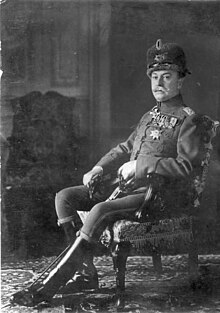Hans Heinrich XV. Prince of Pless
Hans Heinrich XV. Prince von Pless, Count von Hochberg (born April 23, 1861 in Pless , † February 1, 1938 in Paris ) was a German nobleman and mining industrialist.
Life
He was the son of the second Prince of Pless Hans Heinrich XI. von Hochberg and his mother Marie (née Countess von Kleist). After completing his university studies in 1880, he first entered the military and rose to the rank of colonel à la suite . He then entered the diplomatic service and became Legation Secretary in London . There he married Mary-Theresa Cornwallis-West , then known as Daisy (1873-1943), who was then considered a beauty . With this he had three sons: Hans Heinrich XVII . (Henry Pless), Alexander (Aleksander Hochberg-Pszczyński) and Conrad, called Bolko . The family often lived at Fürstenstein Castle . The prince remained in the diplomatic service until 1891.
After his father's death in 1907, he inherited his property. In the dominions of Pleß and Fürstenstein he owned over 50,000 hectares of land. This also included, in particular, abundant coal deposits, most of which, however, had not yet been developed. The forests in which European bison were bred under princely sovereignty were also important . Before the First World War , his fortune was estimated at 100 million marks. The castle Pless and his other possessions were before 1914 a meeting of the aristocratic and wealthy society in Europe.
Prince Pleß had a close relationship with Wilhelm II , who regularly hunted at Schloss Pleß in autumn. The emperor also commissioned the prince with confidential missions. During the First World War, Pless Castle was the seat of the imperial headquarters for months.
After the end of the war and the re-establishment of the Polish state, Hans Heinrich stayed in Upper Silesia . The attempt to sell the entire property before July 12, 1922, the official takeover of Upper Silesia, failed. Hans Heinrich XV. became a Polish citizen. But he was often on trips abroad or lived on the properties in Germany.
In 1922 the prince divorced his wife Daisy. In 1925 he married the Spaniard Clothilde de Silva y Gonzalez de Candamo , Marquesa de Arcicollar (1898–1978), who was several decades younger . Hans Heinrich had a daughter with her, but the marriage was divorced in 1934 after a family scandal: the stepmother had seduced the youngest stepson Conrad, known as Bolko. The two then married.
At the same time there were further disputes within the family: The eldest son, Hans Heinrich XVII. took over the administration of the property in 1932 due to a partial paralysis of the father. Since he was too active on the part of the German minority, conflicts arose with the Polish authorities. Finally, there was a lawsuit because of tax arrears of the Pleß'schen mining management. This ended with the property being placed under forced administration in 1934. In 1937 the German-Polish Agreement on Upper Silesia (Geneva Agreement) , which protected the princely property from expropriation, expired. The prince had to meet the state in order to receive at least part of his property. He renounced the Bergregal in the rule Pless. As a result of the tax debt, 56% of the property located in Poland was nationalized. The mines and industrial companies were incorporated into two joint stock companies, but their shares remained in the possession of the heirs of the prince who died in 1938.
literature
- Norbert Conrads: Pleas. In: New German Biography (NDB). Volume 20, Duncker & Humblot, Berlin 2001, ISBN 3-428-00201-6 , p. 532 f. ( Digitized version ). (Mentioned in family article, p. 533).
- Klemens Skibicki: Industry in the Upper Silesian Principality of Pless in the 18th and 19th centuries. On the economic logic of the transition from a feudal tycoon to a modern industrial enterprise . Steiner, Stuttgart 2002, ISBN 3-515-08036-8 , pp. 160-162.
- Munzinger: Internationales Biographisches Archiv 40/1955 from September 26, 1955.
Web links
- Newspaper article about Hans Heinrich XV. Prince von Pless in the press kit of the 20th century of the ZBW - Leibniz Information Center for Economics .
Individual evidence
- ↑ Cf. “German-Polish Agreement on Upper Silesia” (Upper Silesia Agreement, OSA) of May 15, 1922, in: Reichsgesetzblatt , 1922, Part II, p. 238 ff.
| personal data | |
|---|---|
| SURNAME | Pless, Hans Heinrich XV. Prince of |
| BRIEF DESCRIPTION | German gentleman and mining industrialist |
| DATE OF BIRTH | April 23, 1861 |
| PLACE OF BIRTH | Pszczyna |
| DATE OF DEATH | February 1, 1938 |
| Place of death | Paris |
